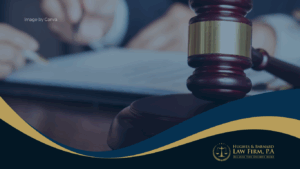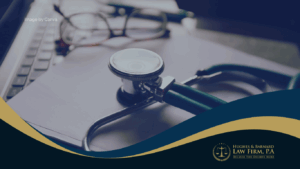
How to Prove Medical Negligence
Written by the Hughes and Barnard Law Firm, PA marketing team and reviewed by Attorney Howard Hughes to ensure quality and accuracy.
Get a Free Consultation Today
ALL FIELDS REQUIRED
Medical negligence can have life-altering consequences, leaving victims with physical, emotional, and financial hardships. If you or a loved one has suffered due to the actions or inactions of a healthcare professional, understanding how to prove medical negligence is essential for pursuing justice. At Hughes and Barnard Law Firm, PA, we are committed to representing victims and ensuring negligent parties are held accountable.
What is Medical Negligence?
Medical negligence occurs when a healthcare provider, such as a doctor, nurse, or hospital, fails to meet the accepted standard of care, resulting in harm to the patient. This failure could involve errors in diagnosis, treatment, aftercare, or health management. Common examples include:
- Misdiagnosis or delayed diagnosis.
- Surgical errors or wrong-site surgeries.
- Medication errors, such as incorrect dosage or prescribing harmful drugs.
- Birth injuries caused by negligence during labor and delivery.
- Failure to monitor a patient’s condition or respond to complications appropriately.
When such errors result in harm, victims may have the right to pursue a medical negligence claim. However, these cases require a detailed understanding of both legal and medical complexities.
How to Prove Medical Negligence
Successfully proving medical negligence involves establishing four critical elements:
1. Duty of Care
You must show that the healthcare provider owed you a duty of care. This is usually straightforward if there was an established doctor-patient relationship, as providers have a legal obligation to deliver competent care.
2. Breach of Duty
Next, you need to demonstrate that the provider violated their duty by failing to meet the accepted standard of care. The standard of care is determined by comparing the provider’s actions to what a similarly qualified professional would have done in the same circumstances. Expert testimony is often essential to establish this breach.
3. Causation
Causation is one of the most challenging aspects of proving medical negligence. You must provide evidence that the breach of duty directly caused your injury or worsened your condition. This may involve detailed medical records, expert opinions, and sometimes even reconstructing events leading to the harm.
4. Damages
Finally, you need to prove that the negligence resulted in actual harm. This harm could include:
- Medical expenses for additional treatment.
- Lost wages due to an inability to work.
- Pain and suffering caused by physical or emotional trauma.
At Hughes and Barnard Law Firm, PA, we have extensive experience gathering the evidence needed to establish these elements and build a compelling case.
How Hard is it to Prove Medical Negligence?
Proving medical negligence can be complex for several reasons:
1. Medical Evidence is Complicated
Medical records and procedures often involve technical details that are difficult for a layperson to interpret. Expert witnesses are usually required to explain how the healthcare provider’s actions fell below the standard of care.

2. The Burden of Proof Rests on the Victim
In a medical negligence case, the victim (plaintiff) must prove that it is more likely than not that the provider’s negligence caused the harm. This standard of proof is known as “preponderance of the evidence.”
3. Defensive Legal Tactics
Healthcare providers and their insurance companies often mount aggressive defenses to avoid liability. They may argue that your injuries were pre-existing or caused by other factors unrelated to their actions.
Despite these challenges, our firm is equipped to navigate these obstacles and advocate for victims. With skilled legal representation, even complex cases can be successfully resolved.
How to Prove a Medical Negligence Case
To prove a medical negligence case, it’s essential to follow a structured approach:
Step 1: Collect Evidence
Start by gathering all relevant medical records, treatment plans, prescriptions, and test results. These documents are the foundation of your case and can help identify where the negligence occurred.
Step 2: Seek Expert Testimony
Medical negligence cases often hinge on expert testimony. An independent medical professional can review your case, compare it to accepted practices, and confirm whether the provider breached the standard of care.
Step 3: Link the Breach to the Harm
Demonstrating causation is critical. This requires connecting the provider’s actions—or lack thereof—to the injury or worsening of your condition.
Step 4: Calculate Damages
Thoroughly document the financial, physical, and emotional toll the negligence has taken on your life. This includes medical bills, lost wages, reduced quality of life, and emotional distress.
Our team at Hughes and Barnard Law Firm, PA, is skilled at managing each of these steps and ensuring your case is as strong as possible.
How Difficult is it to Prove Medical Negligence?
The difficulty of proving medical negligence depends on factors such as:
- The Complexity of the Injury: Cases involving rare conditions or specialized treatments may require more in-depth investigation.
- Availability of Evidence: Incomplete medical records or lack of documentation can make it harder to build a case.
- The Strength of Expert Opinions: Expert witnesses must clearly explain how the provider’s actions deviated from accepted standards.
Despite these challenges, our firm has a track record of success in helping victims overcome these hurdles and secure the justice they deserve.
Why Choose Hughes and Barnard Law Firm, PA?
At Hughes and Barnard Law Firm, PA, we focus exclusively on representing victims of negligence. Our compassionate and experienced team is dedicated to protecting your rights and ensuring that healthcare providers are held accountable for their actions.
Proven Results
We have successfully handled numerous medical negligence cases worth millions of dollars, collectively.
Personalized Attention
We take the time to understand your unique situation and develop a tailored legal strategy.
Comprehensive Support
From gathering evidence to negotiating settlements, we are with you every step of the way.
Dedication to the Pursuit of Justice
Just one oversight from a medical professional can have long-lasting effects on a person’s quality of life and well-being. Mistakes cannot be tolerated, we’re here to make it right.
Contact Us for Help Proving Medical Negligence
If you or someone you love has been harmed due to medical negligence, don’t face the legal system alone. Contact Hughes and Barnard Law Firm, PA, today to schedule a consultation. We are here to guide you through this challenging process and fight for the compensation you deserve.



